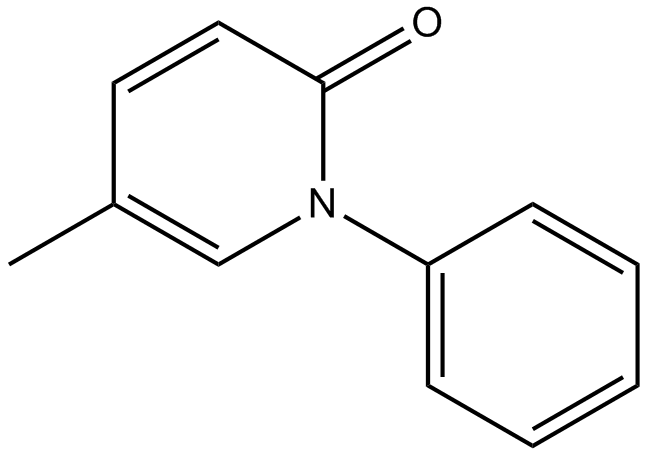Pirfenidone (Synonyms: AMR 69) |
| Catalog No.GC12790 |
La pirfénidone (AMR69) est un agent antifibrotique qui atténue la production de CCL2 et CCL12 dans les cellules fibrocytaires.
Products are for research use only. Not for human use. We do not sell to patients.

Cas No.: 53179-13-8
Sample solution is provided at 25 µL, 10mM.
Pirfenidone,an oral antifibrotic agent, has a broad-spectrum of antifibroticand anti-inflammatory effects. Pirfenidonehas beneficial effects for the treatment of certain fibrotic diseases, and is under clinical trials in patients with idiopathic pulmonary fibrosis.
In vitro: In RAW264.7 cells, Pirfenidone (< 300 μg/mL) suppressed the proinflammatory cytokine tumor necrosis factor-α (TNF-α) through a translational mechanism, which was independent of activation of the mitogen-activated protein kinase (MAPK)2, p38 MAP kinase, and c-Jun N-terminal kinase (JNK)[1]. In LN-18, T98G, LNT-229 and LN-308 cell lines, Pirfenidone (< 10 mM) reduced glioma cell density in a concentration-dependent manner. In CCL-64 cells, Pirfenidone (< 5 mM) reduced TGF-β bioactivity by affecting TGF-β2 mRNA expression and processing of pro-TGF-β. Pirfenidone (< 8.3 mM) inhibited the activity of recombinant furin and downregulated the expression of MMP-11 in a dose-dependent manner in LN-308 cells[2].In cultured myometrial and leiomyoma smooth muscle cells, pirfenidone inhibited serum-stimulated increases in DNA synthesis and cell proliferation in a dose-dependent manner[3].
In vivo: In animals, pirfenidone treatment significantly decreased gene expression of collagens I, III and IV, transforming growth factor β-1, Smad-7, TIMP-1 and PAI-1 [4]. Pirfenidone at a dose of 30 mg/kg/day t.i.d. attenuated the bleomycin-induced pulmonary fibrosi. Pirfenidone (30, 100 mg/kg/day t.i.d) suppressed lung inflammatory edema and pulmonary fibrosis. Pirfenidone suppressed the bleomycin-induced increase in lung interleukin (IL)-1β, IL-6, IL-12\p40 and monocyte chemoattractant protein (MCP)-1 levels and prevented the bleomycin-induced decrease in lung interferon (IFN)-γ levels. Furthermore, pirfenidone suppressed elevation of lung basic-fibroblast growth factor (bFGF), transforming growth factor (TGF)-β1 levels, lung stroma cell derived factor (SDF)-1α and IL-18[5].
Pirfenidoneat (250 mg/kg) potently inhibited the production of the proinflammatory cytokines, TNF-α, interferon-gamma, and interleukin-6, but enhanced the production of the anti-inflammatory cytokine, interleukin-10 in mice [1]. Pirfenidone (250 mg/kg/day) ameliorated cyclosporine-induced fibrosis by about 50% and improved CsA-induced decrease in creatinine clearance. PFD treatment also decreased the TGF-β1 protein expression by 80% in salt-depleted Sprague-Dawley rats [6]. Pirfenidone (400 mg/kg/day) inhibited heat shock protein 47-positive cells and myofibroblasts, the principal cells responsible for the accumulation and deposition of extracellular matrix seen in pulmonary fibrosis in ICR mice intravenously injected with bleomycin [7].
In rats treated with dimethylnitrosamine (10 mg/kg) for 5 weeks, 0.5% pirfenidonereduced the degree of liver injury. Administration of pirfenidone(0.5%, liquid diet)downregulated the elevated levels of those transcripts by 50-60%, and this was associated with a 70% reduction in collagen deposition[8].
Clinical Trials: Pirfenidone is a promising agent for individuals with overt diabetic nephropathy. In the pirfenidone 1200-mg/d group, the mean eGFR increased (+3.3 ± 8.5 ml/min per 1.73 m2) while the mean eGFR decreased in the placebo group (2.2 ± 4.8 ml/min per 1.73 m2;P= 0.026). In the pirfenidone 2400-mg/d group, the dropout rate was high (11 of 25) and the change in eGFR was not significantly different from placebo (1.9 ± 6.7 ml/min per 1.73 m2)[9].
Pirfenidone has entered three Phase III, randomized,double-blind, placebo-controlledstudies in patients withidiopathic pulmonary fibrosis(IPF)[10,11]. In the pirfenidone group, as compared with the placebo group, there was a relative reduction of 47.9% in the proportion of patients who had an absolute decline of 10 percentage points and a relative increase of 132.5% in the proportion of patients with no decline in FVC (P < 0.001). Pirfenidonealso reduced the decline in the 6-minute walk distance (P = 0.04) and improved progression-free survival (P < 0.001). The most common adverse events were gastrointestinal and skin-related diseases [11].
References:
[1]. Nakazato H, Oku H, Yamane S, et al. A novel anti-fibrotic agent pirfenidone suppresses tumor necrosis factor-α at the translational level[J]. European journal of pharmacology, 2002, 446(1): 177-185.
[2]. Burghardt I, Tritschler F, Opitz C A, et al. Pirfenidone inhibits TGF-β expression in malignant glioma cells[J]. Biochemical and biophysical research communications, 2007, 354(2): 542-547.
[3]. Lee B S, Margolin S B, Nowak R A. Pirfenidone: a novel pharmacological agent that inhibits leiomyoma cell proliferation and collagen production[J]. The Journal of Clinical Endocrinology & Metabolism, 1998, 83(1): 219-223.
[4]. Garca L, Hernández I, Sandoval A, et al. Pirfenidone effectively reverses experimental liver fibrosis[J]. Journal of hepatology, 2002, 37(6): 797-805.
[5]. Oku H, Shimizu T, Kawabata T, et al. Antifibrotic action of pirfenidone and prednisolone: different effects on pulmonary cytokines and growth factors in bleomycin-induced murine pulmonary fibrosis[J]. European journal of pharmacology, 2008, 590(1): 400-408.
[6]. Shihab F S, Bennett W M, Yi H, et al. Pirfenidone Treatment Decreases Transforming Growth Factor‐β1 and Matrix Proteins and Ameliorates Fibrosis in Chronic Cyclosporine Nephrotoxicity[J]. American Journal of Transplantation, 2002, 2(2): 111-119.
[7]. Kakugawa T, Mukae H, Hayashi T, et al. Pirfenidone attenuates expression of HSP47 in murine bleomycin-induced pulmonary fibrosis[J]. European Respiratory Journal, 2004, 24(1): 57-65.
[8]. Di Sario A, Bendia E, Macarri G, et al. The anti-fibrotic effect of pirfenidone in rat liver fibrosis is mediated by downregulation of procollagen α1 (I), TIMP-1 and MMP-2[J]. Digestive and liver disease, 2004, 36(11): 744-751.
[9]. Sharma K, Ix J H, Mathew A V, et al. Pirfenidone for diabetic nephropathy[J]. Journal of the American Society of Nephrology, 2011, 22(6): 1144-1151.
[10]. Azuma A, Nukiwa T, Tsuboi E, et al. Double-blind, placebo-controlled trial of pirfenidone in patients with idiopathic pulmonary fibrosis[J]. American journal of respiratory and critical care medicine, 2005, 171(9): 1040-1047.
[11]. King Jr T E, Bradford W Z, Castro-Bernardini S, et al. A phase 3 trial of pirfenidone in patients with idiopathic pulmonary fibrosis[J]. New England Journal of Medicine, 2014, 370(22): 2083-2092.
Average Rating: 5 (Based on Reviews and 23 reference(s) in Google Scholar.)
GLPBIO products are for RESEARCH USE ONLY. Please make sure your review or question is research based.
Required fields are marked with *




















